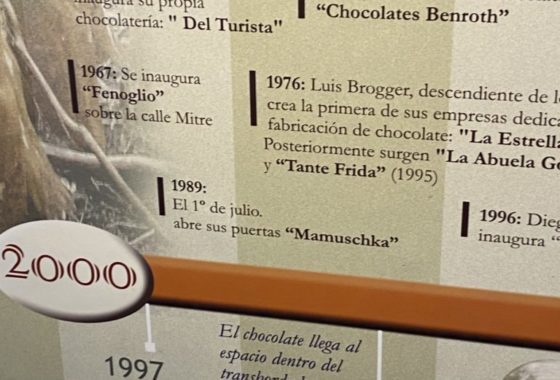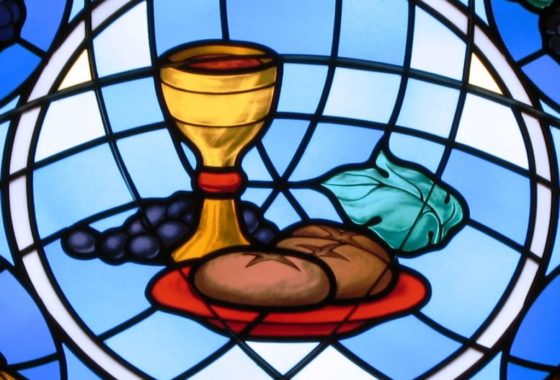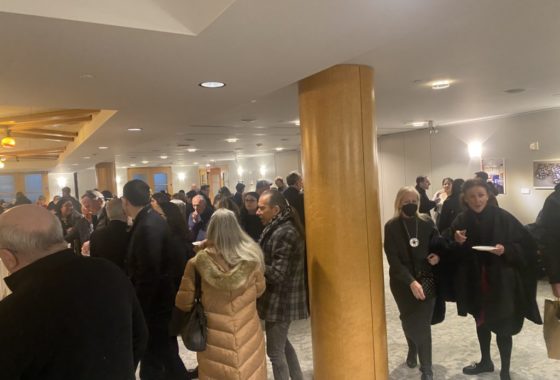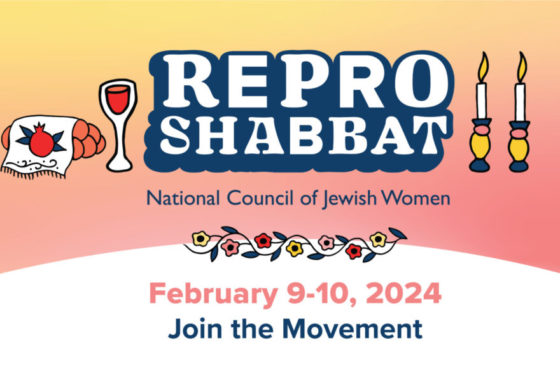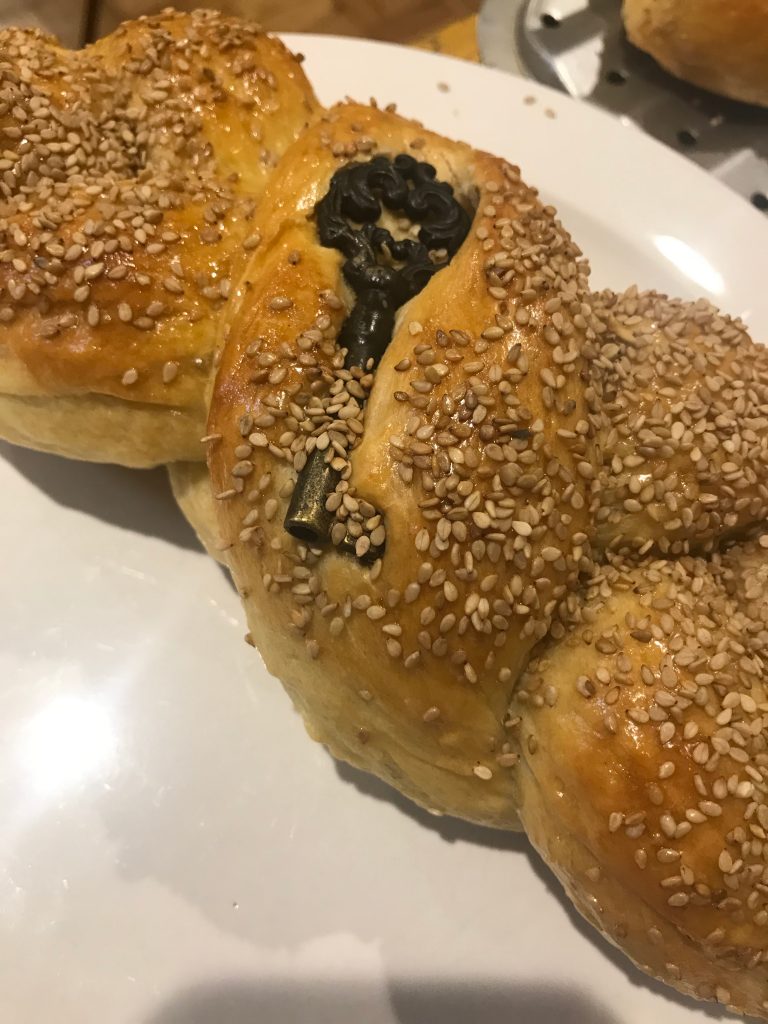
What’s a Key (shlissel) Challah?
On the first Shabbat following Passover, after a week deprived of yeasty breads, hassidic custom serves up not just any challah, but a shlissel or key challah. About seven weeks or fifty days later at Shavuot, challot boast ladders and other symbols signifying ascension to heaven. This key shaped bread or bread embedded with an actual key suggests such access. It pops out of the oven during the days of the Omer, marking the wilderness trek between the Exodus from Egypt and the gift of Torah at Mount Sinai.
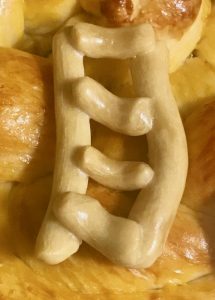
The shlissel has several hassidic sources, including the Belzer and the Satmar rebbes. An early reference, perhaps the first, comes from a student of the Baal Shem Tov, Rabbi Pinchas Shapiro of Kovitz (b. 1726). He taught that during Pesach and for a short period following, the gates of heaven are open. In his view, the key challah focuses prayers in that interlude. Another early source, Rabbi Avraham Yehoshua Heshel, the Apter Rav (b. 1748), refers to it as an ancient custom citing Kabbalistic interpretations about opening the gates of livelihood when manna ceased as the ancient Hebrews entered the Land of Israel (Sefer Ohev Yisrael). There may also be a connection to the reading of Song of Songs for Chol Hamoed (the week of) Pesach, particularly the verse (5:2) “Open for me, my sister.” In addition, some views about the Omer identify each day of the counting with a gate and entrances. Kabbalist Jacob ben Sheshet of Spain connects gates with the five books of Moses as in “Fifty gates consist of five sets of ten gates, each set suggesting one of the five parts of the Pentateuch.”* In the middle of the night of the Shavuot study, the tikkun, the heavens are said to open briefly. The key to this challah embodies this heavenly aura.
Here are some tips for implementing a key design in your challah:
1. Find an elegant old key, clean it well, and impress it deeply into the top of the challah, using your favorite challah dough. Bake the challah as usual and serve with the key in place.
2. Shape the challah into a key form using a twisted or braided dough.
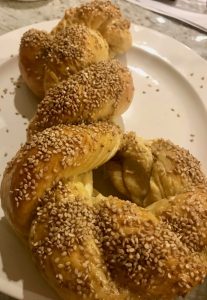
3. Create several knots from the dough and align them into the shape of a key.
4. Use a shaping dough recipe to mold a key to place on top of a braided challah.
Guided by the stunning shlissel challah, the spiritual journey of the omer progresses. This expansive season of growing sun and warmth, symbolized by its decorative challot, culminates at Shavuot, promising the opening our minds to Jewish learning and our hearts to God’s presence.
*See: “Schlissel Challah: An Analysis by Rabbi Yair Hoffman”
Recent Posts
-
On the Chocolate Trail in Bariloche, Argentina
In March, Mark and I finally extended our chocolate trail explorations in celebration of our special anniversary to Bariloche…via Miami, Buenos Aires, Ushuaia, Antarctica, and Buenos Aires again. There were international flights, a cruise, a couple of domestic flights to get there. All of the travel was amazing, but Bariloche, sometimes called the chocolate capital
Read more › -
Sunday Yeast Polemics: On the Bread Trail
Leavened bread or not? While some of us may think of Passover, the question applied to Eucharistic bread and created significant division in the early Christian Church. The leavened bread for Sunday use was often baked at home by women. Over time, preferences shifted to clergy, church-produced, breads… and, the Eastern Orthodox Church preferred a
Read more › -
Sweet Treat: Chocolate and the Making of American Jews
You may wonder: how did chocolate help define American Jews? Through chocolate, we see that Jews were part of America since its earliest days. Well, since 1701 at least, Jews in the Colonies made part of their living through chocolate. Several Sephardim, leaders of their New York and Newport Jewish and secular communities, participated in
Read more › -
How About Some Uterus Challah?
When Logan Zinman Gerber felt enraged about the loss of reproductive rights in the U.S., she baked challah. Not any challah. She shaped it into a uterus. It wasn’t long after the birth of her daughter that Gerber, a longtime challah baker and staff member of the Religious Action Center of the Reform movement, considered
Read more ›
Some Previous Posts
(in alphabetical order)
- "Boston Chocolate Party" Q&As with Deborah Kalb
- 2022 Media for The "Boston Chocolate Party"
- A Manhattan synagogue explores the rich, surprising history of Jews and chocolate
- About Rabbi Deborah Prinz
- Baking Prayers into High Holiday Breads
- Boston Chocolate Party
- Digging into Biblical Breads
- Exhibit Opens! Sweet Treat! Chocolate & the Making of American Jews
- For the Easiest Hanukah Doughnuts Ever
- Forthcoming! On the Bread Trail
- Funny Faced Purim Pastries
- Good Riddance Chameitz or, The Polemics of Passover's Leaven
- How About Some Uterus Challah?
- Injera*
- Jewish Heritage Month: Baseball & Chocolate!
- Matzah - But, the Dough Did Rise!
- Plan a Choco-Hanukkah Party: 250th Anniversary Tea Party
- Prayers Into Breads
- To Shape Dough: A Trio of Techniques
Archives
2025
▾- All
2024
▾- January
- February
- March
- May
- July
- All
2023
▾- March
- April
- May
- June
- August
- November
- December
- All
2022
▾- February
- April
- November
- December
- All
2021
▾- March
- April
- October
- November
- All
2020
▾- April
- May
- June
- October
- December
- All
2019
▾- January
- February
- April
- May
- July
- August
- September
- October
- December
- All
2018
▾- February
- March
- April
- May
- July
- September
- October
- November
- December
- All
2017
▾- January
- February
- March
- July
- September
- October
- November
- December
- All
2016
▾- January
- February
- March
- May
- July
- August
- October
- November
- All
2015
▾- January
- February
- March
- May
- June
- July
- September
- November
- All
2014
▾- February
- April
- May
- June
- August
- September
- November
- All
2013
▾- March
- April
- May
- June
- July
- September
- November
- All
2012
▾- January
- February
- March
- April
- September
- October
- November
- December
- All
2011
▾- April
- July
- August
- October
- November
- All
2010
▾- January
- February
- April
- July
- August
- September
- October
- All
2009
▾- January
- June
- July
- August
- October
- All
2008
▾- August
- September
- October
- November
- All
2007
▾- January
- June
- July
- All
2006
▾- November
- December
- All
